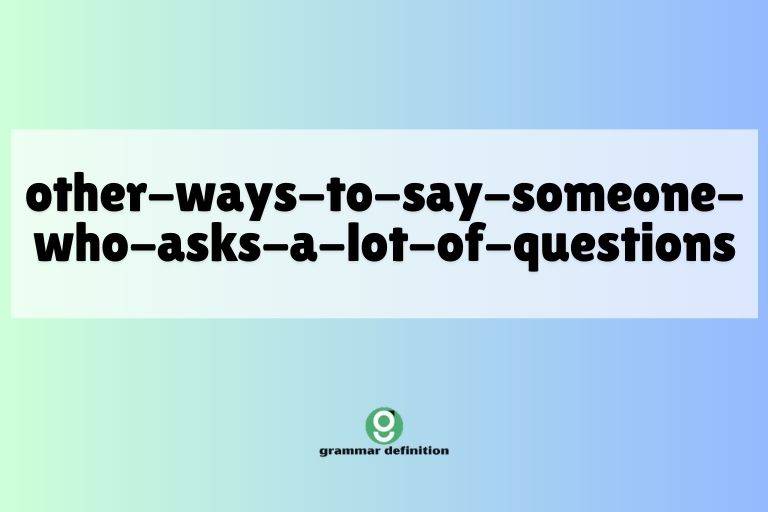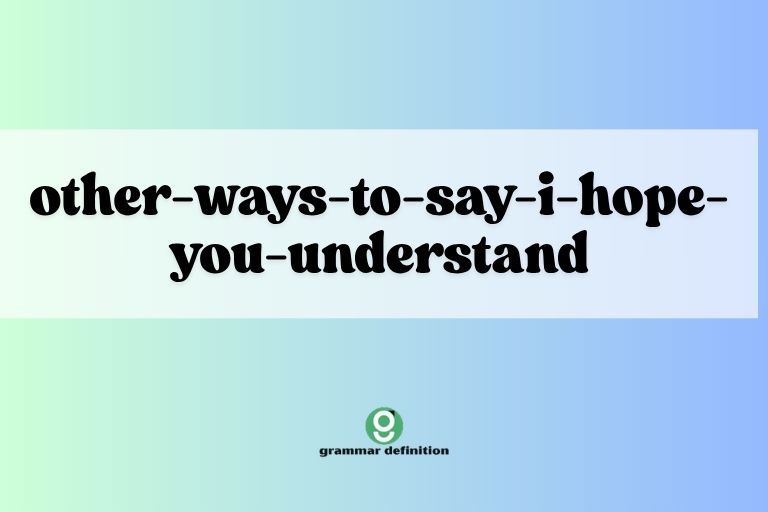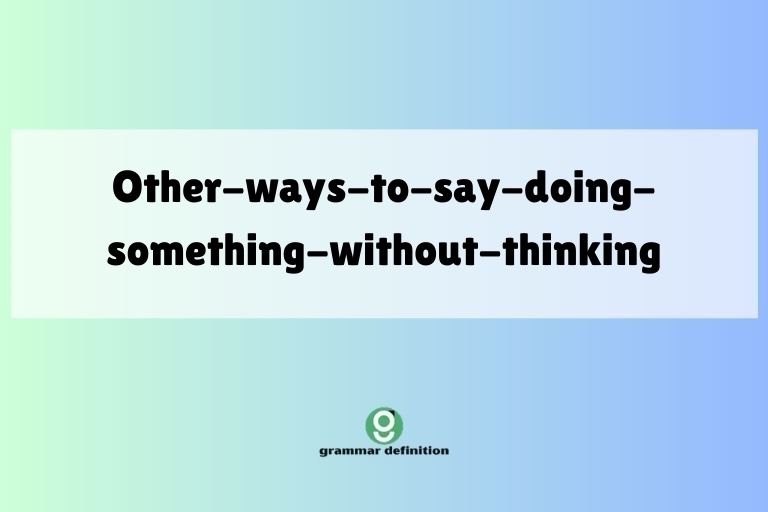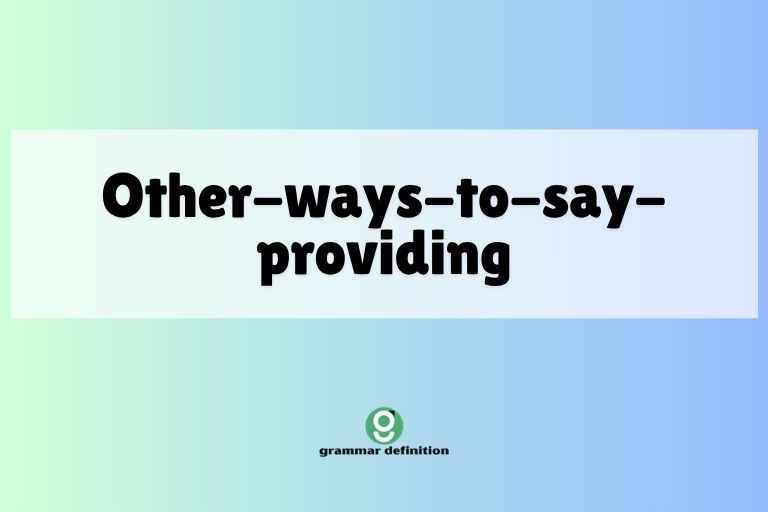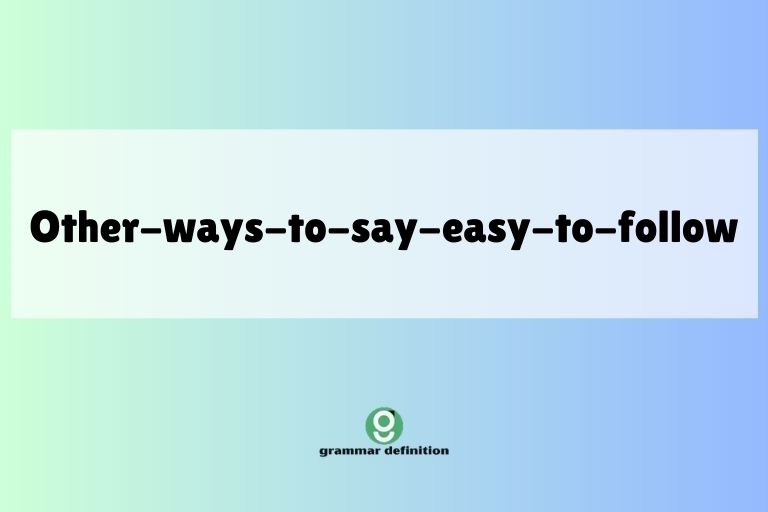Beyond “It’s Okay”: Expanding Your English Repertoire
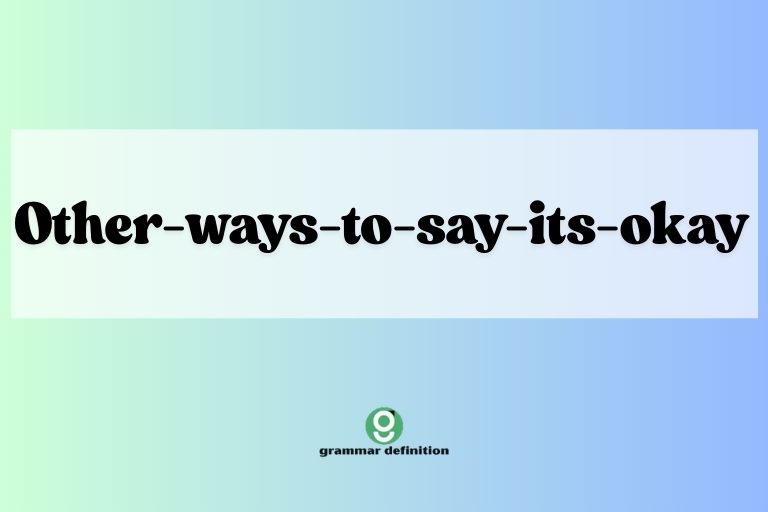
Knowing how to say “it’s okay” in different ways is crucial for effective communication. While “it’s okay” is perfectly acceptable, using a variety of phrases can make your language sound more natural, nuanced, and appropriate for different situations.
This article explores numerous alternatives, providing definitions, examples, and usage guidelines to help you expand your English vocabulary and express yourself more confidently. Whether you’re an ESL learner or a native speaker looking to refine your communication skills, this guide will equip you with the tools to respond to apologies, reassure others, and express acceptance in a variety of engaging and contextually relevant ways.
This article is designed for English language learners of all levels, from beginners to advanced speakers. It will also benefit native English speakers who wish to enhance their vocabulary and improve their communication skills.
By learning these alternative phrases, you can express yourself more precisely and adapt your language to different social and professional contexts.
Table of Contents
- Definition and Basic Understanding
- Structural Breakdown of Common Phrases
- Types and Categories of Alternatives
- Examples in Context
- Usage Rules and Guidelines
- Common Mistakes to Avoid
- Practice Exercises
- Advanced Topics and Nuances
- Frequently Asked Questions
- Conclusion
Definition and Basic Understanding
The phrase “it’s okay” is a common expression used to indicate that something is acceptable, permissible, or not a cause for concern. It is versatile and can be used in various contexts, such as: responding to an apology, offering reassurance, granting permission, or simply acknowledging a situation.
However, relying solely on “it’s okay” can limit the nuance and emotional intelligence conveyed in your communication. Understanding the subtle differences between alternative phrases allows you to tailor your response to the specific situation and the person you are addressing.
This involves considering the level of formality, the emotional context, and the desired impact of your words. Mastering these alternative expressions is a valuable skill for anyone seeking to improve their communication skills and build stronger relationships.
In essence, learning alternatives to “it’s okay” is about expanding your expressive toolkit. It’s about moving beyond a single, default response and choosing the words that best capture the specific meaning you want to convey.
This ability to fine-tune your language enhances your communication, making it more effective, empathetic, and engaging.
Structural Breakdown of Common Phrases
Many alternatives to “it’s okay” follow simple structural patterns. Understanding these patterns can help you generate your own variations and adapt them to different situations.
Here’s a breakdown of some common structures:
- Affirmative Statements: These directly state that there is no problem. Examples include “No problem,” “That’s alright,” and “Everything’s fine.”
- Reassuring Statements: These aim to alleviate concern. Examples include “Don’t worry about it,” “It’s not a big deal,” and “It’s nothing.”
- Acknowledgement Statements: These simply acknowledge the situation without necessarily expressing approval or disapproval. Examples include “I understand,” “I see,” and “That’s understandable.”
- Forgiveness Statements: These explicitly offer forgiveness. Examples include “I forgive you,” “You’re forgiven,” and “Consider it forgotten.”
Identifying the core element of each phrase (affirmation, reassurance, acknowledgement, forgiveness) allows you to choose the most appropriate response for the context. Furthermore, you can modify these structures by adding qualifiers or intensifiers to adjust the level of emphasis.
For instance, “It’s not a big deal” can become “It’s really not a big deal” or “It’s absolutely not a big deal” to convey stronger reassurance.
Types and Categories of Alternatives
The alternatives to “it’s okay” can be categorized based on the intent and context of the phrase. Here are some major categories:
Reassurance and Comfort
These phrases are used to alleviate someone’s worry or guilt. They aim to provide comfort and assurance that the situation is not serious or problematic.
These phrases are particularly useful when someone has made a mistake or is feeling anxious about something they’ve done.
Acceptance and Agreement
These phrases indicate that you accept the situation as it is or agree with a decision or statement. They convey a sense of understanding and willingness to move forward.
These phrases are useful when acknowledging someone’s explanation or agreeing to a proposal.
Forgiveness and Letting Go
These phrases explicitly offer forgiveness and indicate that you are not holding a grudge. They are particularly important in situations where someone has apologized for their actions and is seeking reconciliation.
These phrases help to restore goodwill and maintain positive relationships.
Informal Alternatives
These phrases are suitable for casual conversations with friends, family, or close colleagues. They are generally more relaxed and less formal in tone.
These phrases are ideal for everyday interactions and light-hearted situations.
Formal Alternatives
These phrases are appropriate for professional settings, formal events, or interactions with people you don’t know well. They convey respect and maintain a professional distance.
These phrases are essential for maintaining a polished and respectful demeanor in formal situations.
Examples in Context
Understanding the context in which each phrase is used is crucial for effective communication. Here are several examples, categorized by the types discussed above:
Examples of Reassurance Phrases
These examples illustrate how to use reassurance phrases in various situations to provide comfort and alleviate worry.
| Scenario | Phrase | Explanation |
|---|---|---|
| Someone spills coffee on your table. | “Don’t worry about it. It happens all the time.” | Reassures the person that the spill is not a big deal. |
| A colleague is late submitting a report. | “It’s not a problem. Just get it to me when you can.” | Relieves pressure and emphasizes flexibility. |
| A friend is upset about a minor mistake they made. | “It’s really not a big deal. We all make mistakes.” | Downplays the significance of the mistake and normalizes it. |
| Someone accidentally bumps into you in a crowded place. | “No worries! It’s crowded here.” | Acknowledges the situation and offers reassurance. |
| A student is nervous about a presentation. | “You’ll be fine! Just take a deep breath.” | Provides encouragement and reassurance. |
| A teammate misses a goal during a game. | “It’s alright, we’ll get the next one!” | Offers support and optimism. |
| A child breaks a toy. | “It’s okay, sweetie. We can fix it.” | Provides comfort and a solution. |
| A partner forgets to pick up milk from the store. | “No biggie, I can grab it tomorrow.” | Minimizes the inconvenience. |
| A friend is concerned about a small stain on your shirt. | “It’s nothing, really. I didn’t even notice.” | Dismisses the concern. |
| Someone apologizes for interrupting you. | “It’s totally fine. What did you need?” | Shows understanding and willingness to help. |
| A family member is worried about a medical test. | “Don’t stress about it. We’ll deal with whatever happens.” | Offers support and reduces anxiety. |
| A neighbor apologizes for making noise. | “It’s perfectly alright. I understand it’s daytime.” | Acknowledges the situation and offers understanding. |
| A guest spills a drink at your party. | “No harm done! Let me get you a towel.” | Minimizes the damage and offers assistance. |
| A colleague is worried about a project deadline. | “It’s under control. We’ll get it done.” | Provides confidence and reassurance. |
| A visitor gets lost in your city. | “It’s alright, it’s easy to get turned around here. I can help you find your way.” | Offers assistance and understanding. |
| A friend feels guilty for canceling plans. | “Don’t sweat it. We can reschedule anytime.” | Relieves guilt and offers flexibility. |
| A child is scared after a nightmare. | “It’s just a dream. Everything’s okay now.” | Provides comfort and reassurance. |
| A friend is worried about a job interview. | “You’ll do great! Just be yourself.” | Offers encouragement and reduces anxiety. |
| Someone apologizes for being late to a meeting. | “It’s not an issue. We just started.” | Minimizes the impact of the lateness. |
| A family member is upset about a bad grade. | “It’s okay, it’s just one grade. We’ll work on improving it.” | Provides perspective and support. |
| Someone is feeling down about their appearance. | “You look great! Don’t be so hard on yourself.” | Offers a compliment and reassurance. |
| A friend is worried about a difficult conversation they need to have. | “It’ll be okay. Just be honest and open.” | Provides encouragement and advice. |
| A parent apologizes for missing a child’s event. | “It’s alright, I understand you had to work.” | Acknowledges the reason and offers understanding. |
| A friend is upset about a disagreement with another friend. | “It’ll work itself out. Just give it some time.” | Offers hope and reassurance. |
Examples of Acceptance Phrases
These examples demonstrate how to use acceptance phrases to show understanding and agreement.
| Scenario | Phrase | Explanation |
|---|---|---|
| Someone explains why they couldn’t attend an event. | “That’s understandable. Things come up.” | Shows acceptance of their explanation. |
| A colleague proposes a different approach to a project. | “That’s acceptable. Let’s try it your way.” | Indicates agreement with their suggestion. |
| Someone admits they made a mistake. | “That’s alright. We all make them.” | Accepts their admission and normalizes the situation. |
| A friend explains why they can’t help with a task. | “I understand. No worries.” | Accepts their inability to help without complaint. |
| Someone tells you they need to leave early. | “That’s perfectly acceptable. Thanks for letting me know.” | Acknowledges their need to leave and expresses gratitude. |
| A child explains why they didn’t finish their homework. | “Okay, I understand. Let’s make sure it’s done tomorrow.” | Accepts the explanation while setting expectations. |
| A partner explains why they are feeling stressed. | “I hear you. That makes sense.” | Shows acceptance and understanding of their feelings. |
| A colleague explains why they disagree with your idea. | “That’s a fair point. I appreciate your perspective.” | Accepts their viewpoint and shows respect. |
| Someone tells you they are feeling overwhelmed. | “I get it. Take some time for yourself.” | Accepts their feelings and offers support. |
| A friend explains why they made a certain decision. | “That makes sense. I can see why you did that.” | Accepts their reasoning and shows understanding. |
| Someone explains why they are running late. | “No problem. Thanks for letting me know.” | Accepts the situation and appreciates the communication. |
| A colleague explains why they need to take a day off. | “That’s perfectly fine. Take care of yourself.” | Accepts their need for time off and shows concern. |
| Someone explains why they can’t attend your party. | “That’s quite alright. I appreciate you telling me.” | Accepts their absence and appreciates the communication. |
| A friend explains why they need to borrow something. | “Sure, that’s fine. Just return it when you can.” | Accepts their request and sets expectations. |
| Someone explains why they can’t meet your deadline. | “Okay, I understand. Let’s adjust the timeline.” | Accepts the situation and proposes a solution. |
| A child explains why they made a mess. | “Alright, I see. Let’s clean it up together.” | Accepts the situation and proposes a solution. |
| A partner explains why they are feeling down. | “I’m here for you. Let’s talk about it.” | Accepts their feelings and offers support. |
| A colleague explains why they need help with a task. | “Sure, I can help. What do you need?” | Accepts their need for help and offers assistance. |
| Someone explains why they made a mistake. | “Okay, I understand. Let’s learn from it.” | Accepts the situation and proposes learning from it. |
| A friend explains why they are feeling overwhelmed. | “I get it. Let’s break things down step by step.” | Accepts their feelings and offers a solution. |
| Someone explains why they need to reschedule. | “That’s alright. Let’s find a new time that works.” | Accepts the situation and proposes a solution. |
| A colleague explains why they have to decline a project. | “Okay, I understand. Thanks for letting me know.” | Accepts their decision and appreciates the communication. |
| A friend explains why they are not available this weekend. | “That’s perfectly fine. We’ll catch up another time.” | Accepts their unavailability and suggests an alternative. |
| Someone explains why they prefer a different method. | “That’s a valid point. Let’s consider that option too.” | Accepts their preference and shows willingness to explore it. |
| A child explains why they didn’t want to share a toy. | “Okay, I understand. Let’s talk about sharing.” | Accepts their feelings and proposes a discussion about sharing. |
Examples of Forgiveness Phrases
These examples illustrate how to use forgiveness phrases to show that you are letting go of a grievance and restoring goodwill.
| Scenario | Phrase | Explanation |
|---|---|---|
| Someone sincerely apologizes for hurting your feelings. | “I forgive you. Let’s move on.” | Explicitly offers forgiveness and suggests moving forward. |
| A friend apologizes for breaking a promise. | “You’re forgiven. Just don’t let it happen again.” | Offers forgiveness with a gentle reminder. |
| A colleague apologizes for a mistake that affected your work. | “Consider it forgotten. We all make errors.” | Indicates that the mistake is forgiven and forgotten. |
| Someone apologizes for a past wrongdoing. | “It’s water under the bridge. Don’t worry about it.” | Suggests that the past is forgiven and should not be dwelled upon. |
| A family member apologizes for a misunderstanding. | “I forgive you. Let’s not argue about it anymore.” | Offers forgiveness and seeks to end the conflict. |
| Someone apologizes for gossiping about you. | “I forgive you, but please be mindful in the future.” | Offers forgiveness with a request for future consideration. |
| A friend apologizes for forgetting your birthday. | “You’re forgiven. We all have those moments.” | Offers forgiveness with understanding. |
| A colleague apologizes for missing a deadline. | “Consider it forgotten. Let’s focus on the next steps.” | Indicates forgiveness and shifts focus to the future. |
| Someone apologizes for speaking harshly. | “I forgive you. I understand you were stressed.” | Offers forgiveness with understanding of the circumstances. |
| A family member apologizes for a hurtful comment. | “You’re forgiven, but please think before you speak.” | Offers forgiveness with a reminder to be more thoughtful. |
| Someone apologizes for accidentally damaging something. | “I forgive you. It’s just an object.” | Offers forgiveness and puts the situation in perspective. |
| A friend apologizes for canceling plans last minute. | “You’re forgiven. Things happen.” | Offers forgiveness with understanding. |
| A colleague apologizes for not contributing equally to a project. | “Consider it forgotten. Let’s make sure we’re balanced next time.” | Indicates forgiveness and suggests improvement in the future. |
| Someone apologizes for being insensitive. | “I forgive you. I appreciate your apology.” | Offers forgiveness and acknowledges the apology. |
| A family member apologizes for not being supportive. | “You’re forgiven. I hope we can support each other better going forward.” | Offers forgiveness and expresses hope for future support. |
| Someone apologizes for being distant. | “I forgive you. It’s good to have you back.” | Offers forgiveness and expresses happiness at their return. |
| A friend apologizes for not listening. | “You’re forgiven. Just try to be more attentive in the future.” | Offers forgiveness with a request for improved listening skills. |
| A colleague apologizes for taking credit for your work. | “Consider it forgotten. Let’s make sure credit is given where it’s due from now on.” | Indicates forgiveness and sets expectations for future acknowledgment. |
| Someone apologizes for betraying your trust. | “I forgive you, but it will take time to rebuild that trust.” | Offers forgiveness while acknowledging the need for trust to be rebuilt. |
| A family member apologizes for not being there when you needed them. | “You’re forgiven. I hope you can be there for me in the future.” | Offers forgiveness and expresses hope for future support. |
| Someone apologizes for not understanding your feelings. | “I forgive you, but please try to be more empathetic.” | Offers forgiveness and suggests increased empathy. |
| A friend apologizes for judging you. | “You’re forgiven. Everyone makes mistakes.” | Offers forgiveness with understanding. |
| A colleague apologizes for not defending you. | “Consider it forgotten. Let’s stand up for each other in the future.” | Indicates forgiveness and encourages future support. |
| Someone apologizes for overreacting. | “I forgive you. I understand you were stressed.” | Offers forgiveness with understanding of the circumstances. |
| A family member apologizes for being too critical. | “You’re forgiven, but please try to be more supportive.” | Offers forgiveness with a request for increased support. |
Examples of Informal Phrases
These examples demonstrate how to use informal phrases in casual conversations with friends, family, or close colleagues.
| Scenario | Phrase | Explanation |
|---|---|---|
| A friend apologizes for being late to hang out. | “No worries, dude! I just got here myself.” | Casual reassurance that it’s not a problem. |
| Someone accidentally bumps into you. | “It’s all good!” | Informal way of saying it’s not a big deal. |
| A friend forgets to bring something they promised. | “No biggie! We can do without it.” | Informal way of saying it’s not a problem. |
| Someone apologizes for interrupting you. | “It’s cool. What’s up?” | Informal way of saying it’s fine and asking what they need. |
| A friend spills something at your house. | “Don’t sweat it! I’ll clean it up.” | Informal reassurance and offer to help. |
| Someone says they can’t make it to your party. | “That’s alright. Catch you next time!” | Casual acceptance and a friendly farewell. |
| A friend tells you they messed up. | “Eh, no big deal! We all do.” | Informal reassurance and normalization of mistakes. |
| Someone asks if they can borrow something. | “Sure thing! Just give it back when you’re done.” | Informal agreement and expectation of return. |
| A friend apologizes for not replying to your text sooner. | “No worries! I know you’re busy.” | Casual understanding and acceptance. |
| Someone tells you they are feeling down. | “That’s rough, buddy. Want to talk about it?” | Informal acknowledgment and offer of support. |
| A friend says they can’t help with a task. | “It’s fine, I got it.” | Casual acceptance and assurance that you can handle it. |
| Someone asks if they can change plans. | “Yeah, no problem. Whatever works for you.” | Informal agreement and flexibility. |
| A friend tells you they didn’t like a movie you recommended. | “Eh, it’s all good. Everyone has different tastes.” | Casual acceptance of differing opinions. |
| Someone apologizes for forgetting your name. | “No worries! Happens to the best of us.” | Informal reassurance and normalization of forgetfulness. |
| A friend says they can’t drive you home. | “That’s alright, I’ll catch a ride.” | Casual acceptance and finding an alternative. |
| Someone tells you they are running late. | “It’s cool. I’ll just chill here.” | Informal acceptance and patience. |
| A friend says they can’t afford to go out. | “No biggie. We can just hang at my place.” | Informal understanding and alternative suggestion. |
| Someone asks if they can bring a friend to your party. | “Yeah, sure! The more, the merrier.” | Informal agreement and welcoming attitude. |
| A friend tells you they are feeling stressed. | “That sucks, man. Let’s grab a beer.” | Informal acknowledgment and suggestion for relaxation. |
| Someone asks if they can use your phone. | “Yeah, go for it.” | Informal agreement and permission. |
| A friend apologizes for eating your leftovers. | “It’s all good. I wasn’t that hungry anyway.” | Casual reassurance and dismissal of concern. |
| Someone says they don’t understand something you said. | “My bad. Let me explain it again.” | Informal acknowledgment of fault and willingness to clarify. |
| A friend tells you they are not feeling well. | “That’s a bummer. Take it easy.” | Informal acknowledgment and suggestion for rest. |
| Someone asks if they can borrow your notes. | “Yeah, just make sure to give them back.” | Informal agreement and expectation of return. |
| A friend tells you they are having a bad day. | “That’s rough. Want to vent?” | Informal acknowledgment and offer of support. |
Examples of Formal Phrases
These examples demonstrate how to use formal phrases in professional settings, formal events, or interactions with people you don’t know well.
| Scenario | Phrase | Explanation |
|---|---|---|
| An employee apologizes for a delay in a project. | “That is quite alright, Mr. Smith. Please ensure it is completed by the end of the week.” | Formal acceptance with a clear expectation. |
| A client apologizes for being late to a meeting. | “That is quite alright, Ms. Johnson. We have only just begun.” | Formal reassurance and acknowledgement of the situation. |
| Someone apologizes for a minor mistake in a formal presentation. | “It is perfectly acceptable. Please continue.” | Formal acceptance and encouragement to proceed. |
| A colleague apologizes for misunderstanding instructions. | “That is understandable. I will clarify the details.” | Formal acknowledgement and offer to provide further clarification. |
| An attendee apologizes for accidentally interrupting a speaker. | “That is quite permissible. Please feel free to ask questions.” | Formal acceptance and invitation for further participation. |
| A guest apologizes for spilling a drink at a formal event. | “That is perfectly acceptable. May I offer you assistance?” | Formal reassurance and offer of help. |
| A subordinate apologizes for failing to meet a target. | “That is regrettable, however, we can learn from this. Let us proceed with a revised plan.” | Formal acknowledgement of the failure and a focus on future improvement. |
| A speaker apologizes for exceeding their allotted time. | “That is understandable. Thank you for your comprehensive presentation.” | Formal acceptance and gratitude. |
| A business partner apologizes for a delay in payment. | “That is acceptable, provided the payment is received by the agreed-upon date.” | Formal acceptance with a clear condition. |
| A student apologizes for submitting an assignment late. | “That is acceptable, given the circumstances. However, please ensure timely submission in the future.” | Formal acceptance with a reminder of expectations. |
| A new employee apologizes for asking many questions. | “That is quite acceptable. We encourage you to seek clarification.” | Formal reassurance and encouragement of inquiry. |
| A vendor apologizes for a slight increase in prices. | “That is acceptable, provided the quality remains consistent.” | Formal acceptance with a condition regarding quality. |
| A participant apologizes for disagreeing with a proposal. | “That is perfectly permissible. We value diverse perspectives.” | Formal acceptance and appreciation of varied opinions. |
| A staff member apologizes for wearing inappropriate attire on a casual Friday. | “That is quite acceptable, as it is a casual day. However, please ensure adherence to the dress code on regular workdays.” | Formal acceptance with a reminder of standard protocols. |
| A visiting dignitary apologizes for a minor cultural faux pas. | “That is perfectly acceptable. We understand cultural differences.” | Formal reassurance and understanding of cultural nuances. |
| An applicant apologizes for a typo in their application. | “That is acceptable. We appreciate your attention to detail in general.” | Formal acceptance with a general compliment. |
| A presenter apologizes for a technical glitch during a webinar. | “That is understandable. We appreciate your patience.” | Formal acknowledgement and gratitude for patience. |
| A contractor apologizes for a slight deviation from the original plan. | “That is acceptable, provided the final outcome aligns with the intended objectives.” | Formal acceptance with a condition regarding the final result. |
| A consultant apologizes for a minor oversight in their report. | “That is acceptable. We value your comprehensive analysis.” | Formal acceptance with a compliment on the overall analysis. |
| A speaker apologizes for a slight mispronunciation. | “That is perfectly permissible. We appreciate your clear communication.” | Formal reassurance and appreciation of communication skills. |
| A sponsor apologizes for reducing their contribution amount. | “That is acceptable, provided the terms of the partnership remain beneficial.” | Formal acceptance with a condition regarding the partnership benefits. |
| A supplier apologizes for a minor discrepancy in the delivery. | “That is acceptable, provided the issue is rectified promptly.” | Formal acceptance with a condition regarding swift resolution. |
| A committee member apologizes for missing a meeting. | “That is acceptable, given the prior notification. We appreciate your commitment.” | Formal acceptance with acknowledgement of prior notice and appreciation of commitment. |
| An interviewee apologizes for lacking specific experience. | “That is understandable. We value your transferable skills.” | Formal acknowledgement and appreciation of transferable skills. |
| A volunteer apologizes for not being available for an event. | “That is acceptable, provided we receive sufficient notice. We appreciate your willingness to assist.” | Formal acceptance with a condition regarding notice and appreciation of willingness. |
Usage Rules and Guidelines
When choosing an alternative to “it’s okay,” consider the following rules and guidelines:
- Context is Key: The most important factor is the situation. A casual apology from a friend calls for a different response than a formal apology from a client.
- Relationship Matters: Your relationship with the person you’re addressing influences your choice of words. Intimate relationships allow for more informal and affectionate responses.
- Tone and Body Language: Your tone of voice and body language should match the phrase you use. A sincere “I forgive you” should be delivered with genuine warmth.
- Avoid Sarcasm: Be careful not to use phrases that could be interpreted sarcastically, especially in formal
situations. Sarcasm can damage relationships and undermine trust.
- Be Genuine: Your response should reflect your true feelings. If you’re not truly okay with something, it’s better to express your concerns constructively rather than offering a disingenuous “it’s okay.”
- Consider Cultural Differences: Different cultures have different norms for expressing acceptance and forgiveness. Be mindful of these differences when communicating with people from other cultures.
Common Mistakes to Avoid
While expanding your vocabulary is beneficial, it’s essential to avoid common mistakes that can undermine your message. Here are some pitfalls to watch out for:
- Overusing Formal Language in Informal Settings: Using overly formal phrases with friends or family can sound stiff or unnatural. Save the formal language for professional contexts.
- Using Informal Language in Formal Settings: Conversely, using slang or casual phrases in a formal setting can be disrespectful or unprofessional.
- Offering Empty Reassurance: Saying “Don’t worry about it” when someone has a legitimate concern can invalidate their feelings. Make sure your reassurance is genuine and empathetic.
- Being Passive-Aggressive: Avoid phrases that sound like “it’s okay” but carry an underlying tone of resentment or disapproval. For example, saying “It’s fine” in a clipped tone can be interpreted as sarcastic.
- Using Clichés Inappropriately: While clichés can be useful, overusing them or using them in the wrong context can make your language sound unoriginal or insincere.
- Failing to Acknowledge the Other Person’s Feelings: Simply saying “It’s okay” without acknowledging the other person’s emotions can make you seem dismissive. Show empathy and understanding before offering reassurance.
Practice Exercises
To solidify your understanding and improve your ability to use these alternative phrases, try the following exercises:
Exercise 1: Scenario Response
For each of the following scenarios, write down three different ways you could respond instead of saying “it’s okay.” Consider the context and the relationship you have with the person involved.
- A friend is late for your dinner date.
- A colleague makes a mistake on a shared project.
- Your child breaks a household item.
- A client expresses dissatisfaction with your service.
- A stranger accidentally steps on your foot.
Exercise 2: Phrase Categorization
Categorize the following phrases into the categories of Reassurance, Acceptance, Forgiveness, Informal, and Formal. Some phrases may fit into multiple categories.
- “No problem.”
- “That’s quite alright.”
- “Don’t sweat it.”
- “I forgive you.”
- “That’s understandable.”
- “It’s all good.”
- “Consider it forgotten.”
- “That is perfectly acceptable.”
- “It’s no biggie.”
- “You’re forgiven.”
Exercise 3: Role-Playing
Partner with a friend or colleague and role-play different scenarios where someone apologizes or expresses concern. Practice using a variety of alternative phrases and pay attention to your tone of voice and body language.
Advanced Topics and Nuances
Beyond the basic alternatives, there are more advanced nuances to consider when responding to apologies or concerns. These include:
- Conditional Acceptance: Expressing acceptance with a condition. For example, “I forgive you, but I need you to understand the impact of your actions.”
- Expressing Disappointment: Acknowledging that you are not entirely happy with the situation but are willing to move forward. For example, “I’m disappointed, but I understand. Let’s work together to prevent this from happening again.”
- Setting Boundaries: Using the opportunity to establish clear boundaries. For example, “I accept your apology, but I need you to respect my personal space in the future.”
- Offering Constructive Criticism: Providing feedback to help the person avoid making the same mistake again. For example, “It’s okay, but next time, please double-check the figures before submitting the report.”
- Using Humor Appropriately: In some informal situations, humor can be a good way to defuse tension and offer reassurance. However, be careful not to use humor that could be interpreted as insensitive or dismissive.
Frequently Asked Questions
When is it better to say “it’s okay” rather than an alternative phrase?
Sometimes, “it’s okay” is the most appropriate response, especially in situations where a simple, straightforward acknowledgment is sufficient. For example, if someone accidentally bumps into you in a crowded place, a simple “it’s okay” is often the best response.
How can I tell if someone is being sincere when they apologize?
Pay attention to their body language, tone of voice, and the specific words they use. A sincere apology typically includes an acknowledgment of the wrongdoing, an expression of remorse, and a commitment to making amends.
What if I’m not really okay with what happened?
It’s important to be honest about your feelings. Instead of saying “it’s okay” when you’re not, express your concerns constructively.
For example, you could say, “I’m still a little upset, but I’m willing to work through it.”
How can I improve my ability to choose the right phrase in different situations?
Practice, observation, and feedback are key. Pay attention to how other people respond in similar situations and ask for feedback from trusted friends or colleagues.
Conclusion
Mastering alternatives to “it’s okay” is a valuable skill that can enhance your communication, build stronger relationships, and improve your overall emotional intelligence. By considering the context, your relationship with the person you’re addressing, and your own genuine feelings, you can choose the phrase that best conveys your intended message.
Remember to practice these alternatives in different situations and be mindful of common mistakes. With time and effort, you’ll be able to confidently and effectively express acceptance, reassurance, and forgiveness in a variety of engaging and contextually relevant ways.

